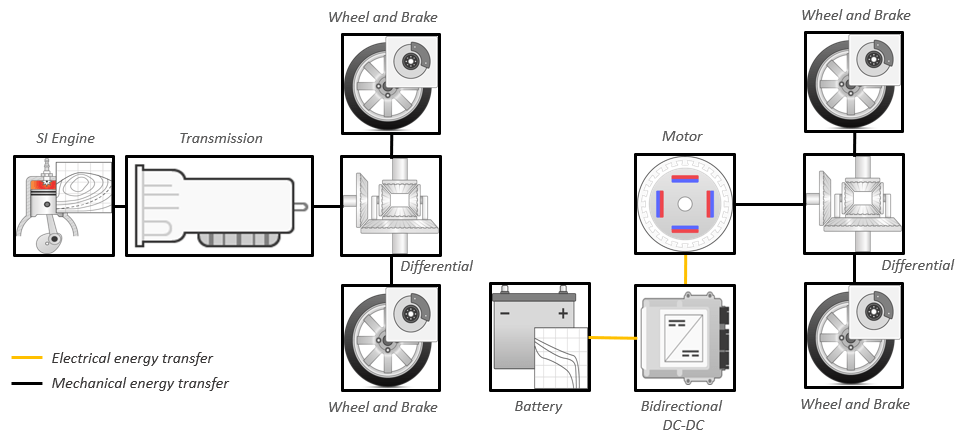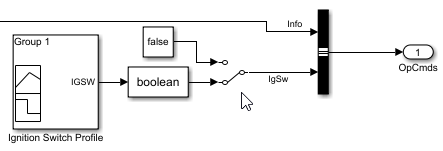The hybrid electric vehicle (HEV) P4 reference application represents a full HEV model with an internal combustion engine, transmission, battery, motor, and associated powertrain control algorithms. Use the reference application for hardware-in-the-loop (HIL) testing, tradeoff analysis, and control parameter optimization of a HEV P4 hybrid. To create and open a working copy of the reference application project, enter
By default, the HEV P4 reference application is configured with:Lithium-ion battery pack
Mapped electric motor
Mapped spark-ignition (SI) engine
This diagram shows the powertrain configuration.

This table describes the blocks and subsystems in the reference application, indicating which subsystems contain variants. To implement the model variants, the reference application uses variant subsystems.
| Reference Application Element | Description | Variants |
|---|---|---|
Analyze Power and Energy |
Double-click Analyze Power and Energy to open a live script. Run the script to evaluate and report power and energy consumption at the component- and system-level. For more information about the live script, see Analyze Power and Energy. | NA |
Drive Cycle Source block — FTP75 (2474 seconds) | Generates a standard or user-specified drive cycle velocity versus time profile. Block output is the selected or specified vehicle longitudinal speed. | ✓ |
Environment subsystem | Creates environment variables, including road grade, wind velocity, and atmospheric temperature and pressure. | |
Longitudinal Driver subsystem |
Uses the Longitudinal Driver or Open Loop variant to generate normalized acceleration and braking commands.
| ✓ |
Controllers subsystem | Implements a powertrain control module (PCM) containing a P4 hybrid control module (HCM), an engine control module (ECM), and a transmission control module (TCM). | ✓ |
Passenger Car subsystem | Implements a hybrid passenger car that contains drivetrain, electric plant, and engine subsystems. | ✓ |
Visualization subsystem | Displays vehicle-level performance, battery state of charge (SOC), fuel economy, and emission results that are useful for powertrain matching and component selection analysis. |
Double-click Analyze Power and Energy to open a live script. Run the script to evaluate and report power and energy consumption at the component- and system-level. For more information about the live script, see Analyze Power and Energy.
The script provides:
An overall energy summary that you can export to an Excel® spreadsheet.
Engine plant, electric plant, and drivetrain plant efficiencies, including an engine histogram of time spent at the different engine plant efficiencies.
Data logging so that you can use the Simulation Data Inspector to analyze the powertrain efficiency and energy transfer signals.
For more information about the live script, see Analyze Power and Energy.
The Drive Cycle Source block generates a target vehicle velocity for a
selected or specified drive cycle. The reference application has these options.
| Timing | Variant | Description |
|---|---|---|
Output sample time |
| Continuous operator commands |
| Discrete operator commands |
The Longitudinal Driver subsystem generates normalized acceleration and
braking commands. The reference application has these variants.
Block Variants | Description | ||
|---|---|---|---|
Longitudinal Driver (default) | Control |
| PI control with tracking windup and feed-forward gains that are a function of vehicle velocity. |
| Optimal single-point preview (look ahead) control. | ||
| Proportional-integral (PI) control with tracking windup and feed-forward gains. | ||
Low-pass filter (LPF) |
| Use an LPF on target velocity error for smoother driving. | |
| Do not use a filter on velocity error. | ||
Shift |
| Stateflow® chart models reverse, neutral, and drive gear shift scheduling. | |
| Input gear, vehicle state, and velocity feedback generates acceleration and braking commands to track forward and reverse vehicle motion. | ||
| No transmission. | ||
| Stateflow chart models reverse, neutral, park, and N-speed gear shift scheduling. | ||
Open Loop | Open-loop control subsystem. In the subsystem, you can configure the acceleration, deceleration, gear, and clutch commands with constant or signal-based inputs. | ||
To idle the engine at the beginning of a drive cycle and simulate catalyst light-off before
moving the vehicle with a pedal command, use the Longitudinal Driver variant. The Longitudinal
Driver subsystem includes an ignition switch signal profile, IgSw. The engine
controller uses the ignition switch signal to start both the engine and a catalyst light-off
timer.
The catalyst light-off timer overrides the engine stop-start (ESS) stop function control
while the catalyst light-off timer is counting up. During the simulation, after the
IgSw down-edge time reaches the catalyst light-off time
CatLightOffTime, normal ESS operation resumes. If there is no torque
command before the simulation reaches the EngStopTime, the ESS shuts down the
engine.
To control ESS and catalyst light-off:
In the Longitudinal Driver Model subsystem, set the ignition switch profile
IgSw to 'on'.

In the engine controller model workspace, set these calibration parameters:
EngStopStartEnable — Enables ESS. To disable ESS, set the
value to false.
CatLightOffTime — Engine idle time from engine start to
catalyst light-off.
EngStopTime — ESS engine run time after driver model torque
request cut-off.
The Controller subsystem has a PCM containing an ECM, HCM, and TCM. The controller has these variants.
| Controller | Variant | Description | |
|---|---|---|---|
| ECM | SiEngineController (default) | Implements the SI Controller | |
CiEngineController | Implements the CI Controller | ||
| HCM |
| Implements the Equivalent Consumption Minimization Strategy | |
| TCM |
| Implements the transmission controller | |
To implement a passenger car, the Passenger Car subsystem
contains drivetrain, electric plant, and engine subsystems. To create your own
engine variants for the reference application, use the CI and SI engine project
templates. The reference application has these variants.
| Drivetrain Subsystem | Variant | Description | |
|---|---|---|---|
Differential and Compliance |
| You can vary the type of coupling torque and efficiency. By default, the differential is configured with an ideal wet clutch and constant efficiency. | |
| You can vary the type of differential efficiency. By default, the open differential is configured with a constant efficiency | ||
Torque Converter Automatic Transmission | Ideal Fixed Gear
Transmission | Configure locked and unlocked transmission efficiency with either a 1D or 4D (default) lookup table. | |
Torque Converter | Configure for external, internal (default), or no lockup. | ||
Vehicle | Vehicle Body 1 DOF
Longitudinal | Configured for 1 degrees of freedom | |
Wheels and Brakes |
| For the wheels, you can configure the type of:
For performance and clarity, to determine the longitudinal force of each wheel, the variants implement the Longitudinal Wheel block. To determine the total longitudinal force of all wheels acting on the axle, the variants use a scale factor to multiply the force of one wheel by the number of wheels on the axle. By using this approach to calculate the total force, the variants assume equal tire slip and loading at the front and rear axles, which is common for longitudinal powertrain studies. If this is not the case, for example when friction or loads differ on the left and right sides of the axles, use unique Longitudinal Wheel blocks to calculate independent forces. However, using unique blocks to model each wheel increases model complexity and computational cost. | |
| |||
Simscape Drivetrain. Another way to customize the drivetrain is to select a Simscape™ variant. This variant incorporates physical connections to provide a flexible way to assemble components.
Use the button in the top level of the reference application to toggle between Simscape and Powertrain Blockset variants of the drivetrain subsystem.
The reference application sets the appropriate solvers to optimize performance for each engine and drivetrain combination. Select the engine variant first, then select the drivetrain using the toggle button. If you select the drivetrain before changing the engine, you may encounter a solver error.
| Electric Plant Subsystem | Variant | Description |
|---|---|---|
Battery | BattHevP4 | Configured with Lithium Ion battery |
Electric Machine | MotMapped | Mapped Motor with implicit controller |
| Engine Subsystem | Variant | Description | |
|---|---|---|---|
| Engine |
| Dynamic SI Core Engine with turbocharger | |
| Mapped SI Engine with implicit turbocharger | ||
| Dynamic naturally aspirated SI Core Engine | ||
MathWorks® used the SI Core Engine and SI Controller to calibrate the hybrid control module (HCM). If you use the CI Core Engine and CI Controller variants, the simulation may error because the HCM does not use calibrated results.
MathWorks would like to acknowledge the contribution of Dr. Simona Onori to the ECMS optimal control algorithm implemented in this reference application. Dr. Onori is a Professor of Energy Resources Engineering at Stanford University. Her research interests include electrochemical modeling, estimation and optimization of energy storage devices for automotive and grid-level applications, hybrid and electric vehicles modeling and control, PDE modeling, and model-order reduction and estimation of emission mitigation systems. She is a senior member of IEEE®.
[1] Balazs, A., Morra, E., and Pischinger, S., Optimization of Electrified Powertrains for City Cars. SAE Technical Paper 2011-01-2451. Warrendale, PA: SAE International Journal of Alternative Powertrains, 2012.
[2] Onori, S., Serrao, L., and Rizzoni, G., Hybrid Electric Vehicles Energy Management Systems. New York: Springer, 2016.
CI Controller | CI Core Engine | Drive Cycle Source | Longitudinal Driver | Mapped CI Engine | Mapped Motor | Mapped SI Engine | SI Controller | SI Core Engine